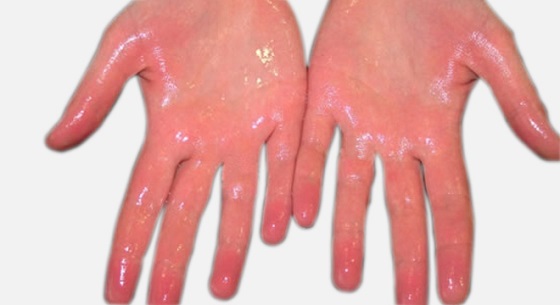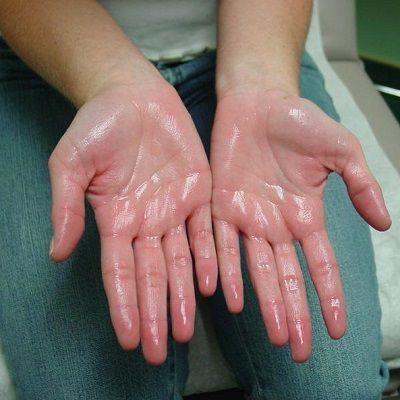Best Dermatology Approaches for Sweaty Hands Treatment: Tips and Techniques
Best Dermatology Approaches for Sweaty Hands Treatment: Tips and Techniques
Blog Article
Unveiling the Intricacies of Excessive Sweating: A Comprehensive Guide to Medical Diagnosis and Monitoring
Too much sweating, clinically recognized as hyperhidrosis, is a condition that affects a substantial number of individuals and can have a profound effect on their high quality of life. While sweating is an all-natural bodily feature, its overactivity in hyperhidrosis offers a special collection of challenges that commonly go beyond mere pain.

Understanding Hyperhidrosis Causes
Hyperhidrosis triggers can be associated to various variables such as genetics, hormone inequalities, and particular clinical problems. Genes play a substantial role in key focal hyperhidrosis, where individuals acquire the problem from their household members. By determining the particular variables contributing to excessive sweating, healthcare companies can tailor treatment plans to address the underlying reason, offering alleviation and enhancing the quality of life for individuals affected by hyperhidrosis.
Identifying Hyperhidrosis Effects

Furthermore, hyperhidrosis symptoms might manifest in emotional and social distress, as people might feel embarrassed or distressed regarding their sweating, leading to avoidance of social scenarios (How to stop sweaty hands). Furthermore, duplicated episodes of extreme sweating can cause skin maceration, fungal infections, and a total reduction in self-confidence
Diagnostic Refine for Hyperhidrosis
Launching the analysis procedure for excessive sweating involves comprehensive analysis of the person's clinical background and checkup. Inquiring about the beginning, period, and activates of sweating episodes is critical to separate between main focal hyperhidrosis and second generalised hyperhidrosis. Case history should also consist of inquiries concerning drugs, medical conditions, and household history of hyperhidrosis.
Throughout the health examination, particular attention is paid to the areas impacted by sweating. The health care copyright might analyze the degree of sweating, look for signs of underlying conditions, and examine the effect of sweating on the person's lifestyle. In addition, specific examinations like the gravimetric examination, starch-iodine test, or skin conductance dimensions might be carried out to evaluate the amount of sweat produced.
Moreover, in cases where second hyperhidrosis is believed, added tests such as blood examinations, urine tests, and imaging studies might be suggested to identify the underlying root cause of excessive sweating. The diagnostic process intends to properly identify the kind and source of hyperhidrosis to guide proper management approaches.
Treatment Choices for Hyperhidrosis
When addressing extreme sweating, various treatment alternatives are offered to ease signs and symptoms and improve the individual's high quality of life. The treatment strategy for hyperhidrosis depends on the extent of symptoms and the patient's response to initial therapies.
Topical treatments, such as aluminum-based antiperspirants, are frequently recommended as the very first line of protection for handling moderate cases of hyperhidrosis. These items function by plugging the sweat ducts, thus lowering the quantity of sweat that gets to the skin's surface area. For people with a lot more severe symptoms, oral drugs like anticholinergics might be prescribed to assist decrease sweating. However, these medicines can have negative effects and are not ideal for every person.

Effective Administration Strategies
To properly take care of hyperhidrosis, a comprehensive and personalized treatment plan tailored to the person's particular requirements and feedback to previous therapies is crucial. Iontophoresis, my explanation including the usage of a reduced electric present to reduce sweat gland task, can be useful for both palmoplantar and axillary hyperhidrosis. A multidisciplinary technique entailing dermatologists, key care physicians, and, if required, surgeons, can optimize the management of hyperhidrosis.
Final Thought
In final thought, hyperhidrosis is a condition defined by too much sweating, which can greatly affect an individual's quality of life. With anchor proper diagnosis and administration methods, people suffering from hyperhidrosis can discover alleviation and boost their total health.
Excessive sweating, clinically understood as hyperhidrosis, is a condition that impacts a significant number of people and can have a profound effect on their high quality of life. By recognizing the details aspects contributing to excessive sweating, health care providers can customize therapy strategies to deal with the underlying reason, offering alleviation and boosting the top quality of life for people impacted by hyperhidrosis.
Hyperhidrosis, defined by too much sweating beyond what is needed for managing body temperature, can dramatically influence a person's top quality of life. Making inquiries regarding the onset, duration, and triggers of sweating episodes is critical to set apart in between key focal hyperhidrosis and second generalized hyperhidrosis. Treatment for hyperhydrosis of hands.In conclusion, hyperhidrosis is a problem identified by too much sweating, which can significantly affect a person's high quality of life
Report this page